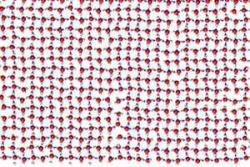An international team of researchers from The University of Manchester, the University of Ulm in Germany and the University of Science and Technology of China created a transparent nanosized graphene capillary to investigate the atomic structure of water trapped inside.

The findings shed light on the unexpected behaviour of water at the molecular scale and are important for development of more efficient water treatment technologies including filtration, desalination and distillation.
A few monolayers of water cover every surface around us, even in driest deserts, and fill in every single microscopic crack. Some places, like capillaries deep inside a bulk material, are hidden from sight and are hard to investigate. The researchers used high magnification electron microscopy that allowed them to see individual water molecules, and the nano-capillary was made from graphene too thin to obscure electron microscopy imaging.
In places where graphene capillaries were narrow enough, the scientists found small square crystals of ice at room temperature. Water molecules formed a square lattice, sitting along evenly spaced rows positioned perpendicularly to each other. Using computer simulations, the researchers attempted to find how common square ice is in nature. The results show that, if the layer of water is thin enough, it should form square ice independently of an exact chemical makeup of confining walls of a nanopore.
It is therefore quite likely that square ice is very common on the molecular scale and present at the tip of many microscopic crack or pore in any material. The scientists explained that microscopic cracks are present everywhere, not only on this planet. So understanding that water on a nanoscale behaves so differently from the common bulk water is important for better understanding of materials.